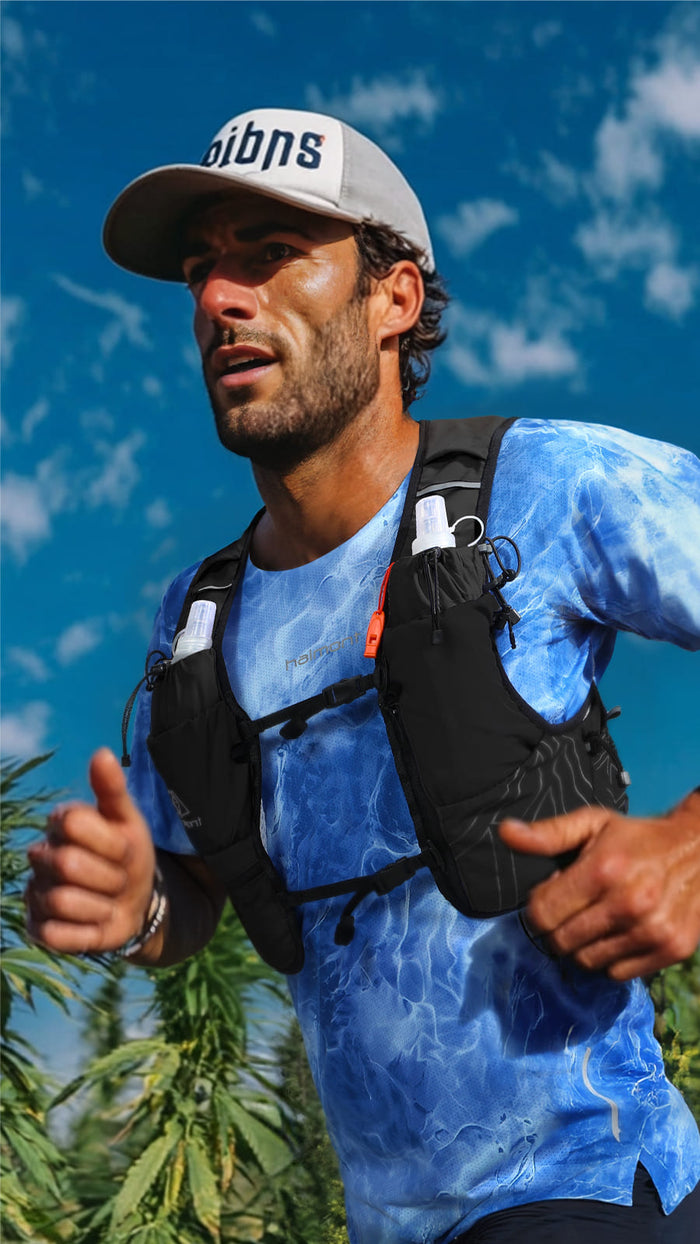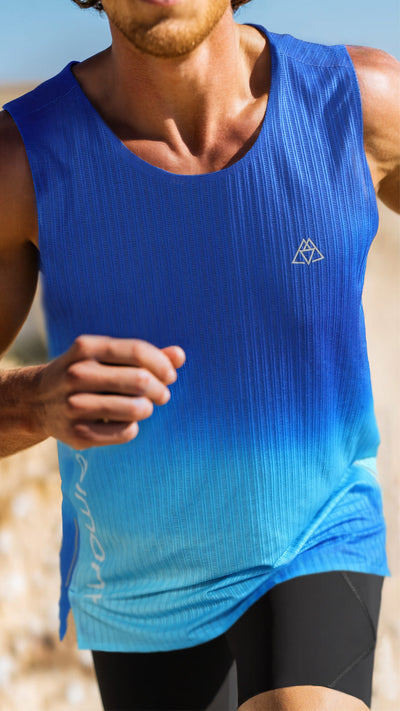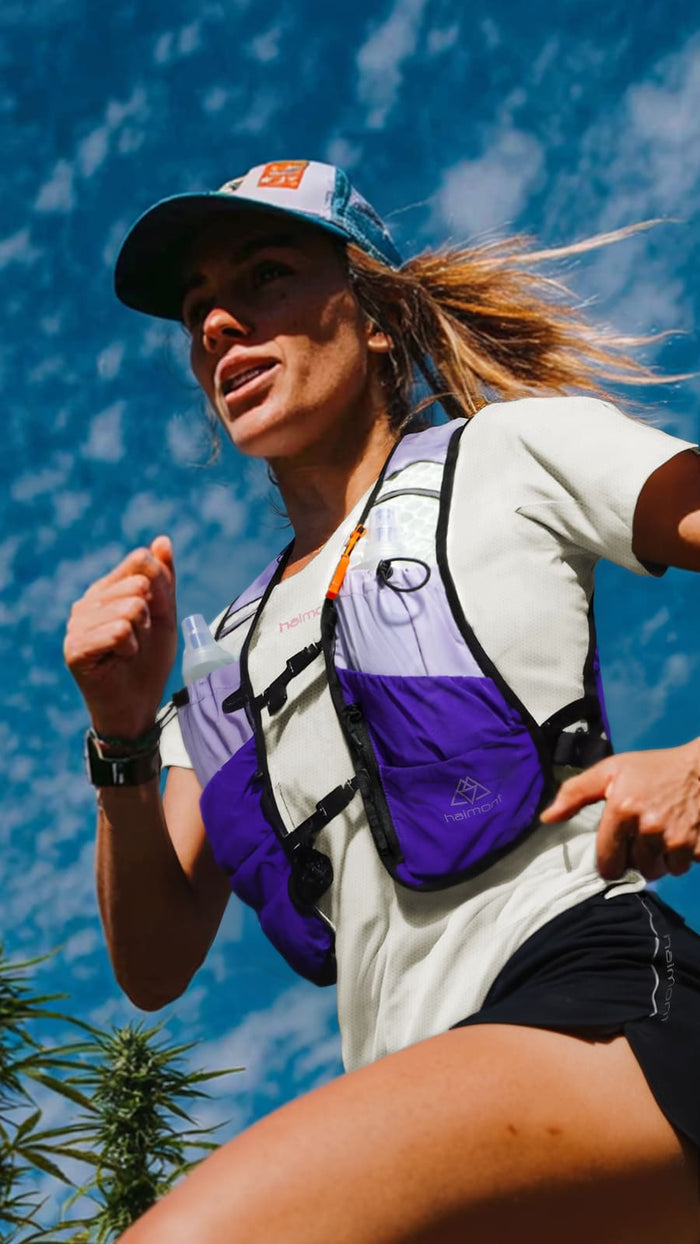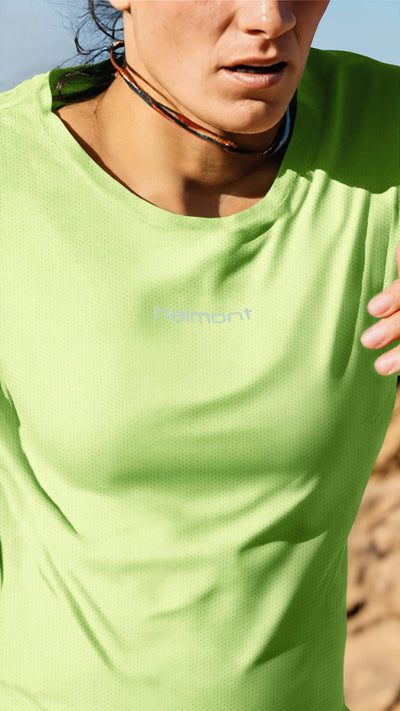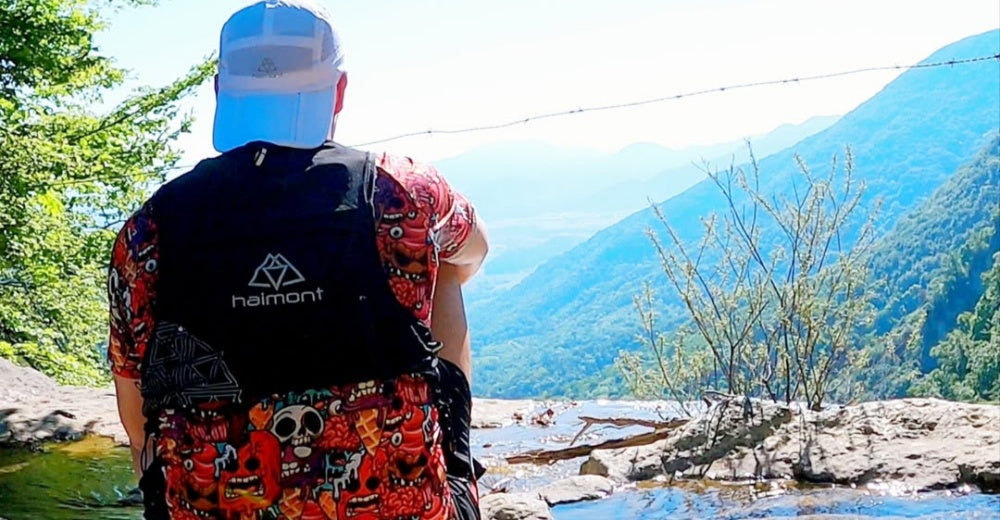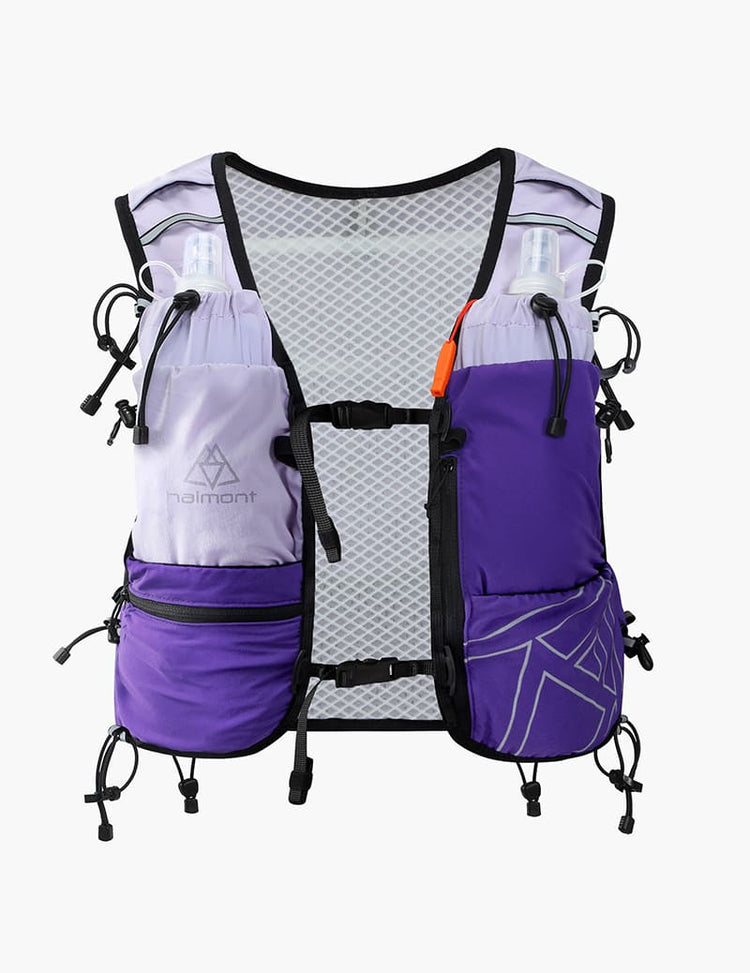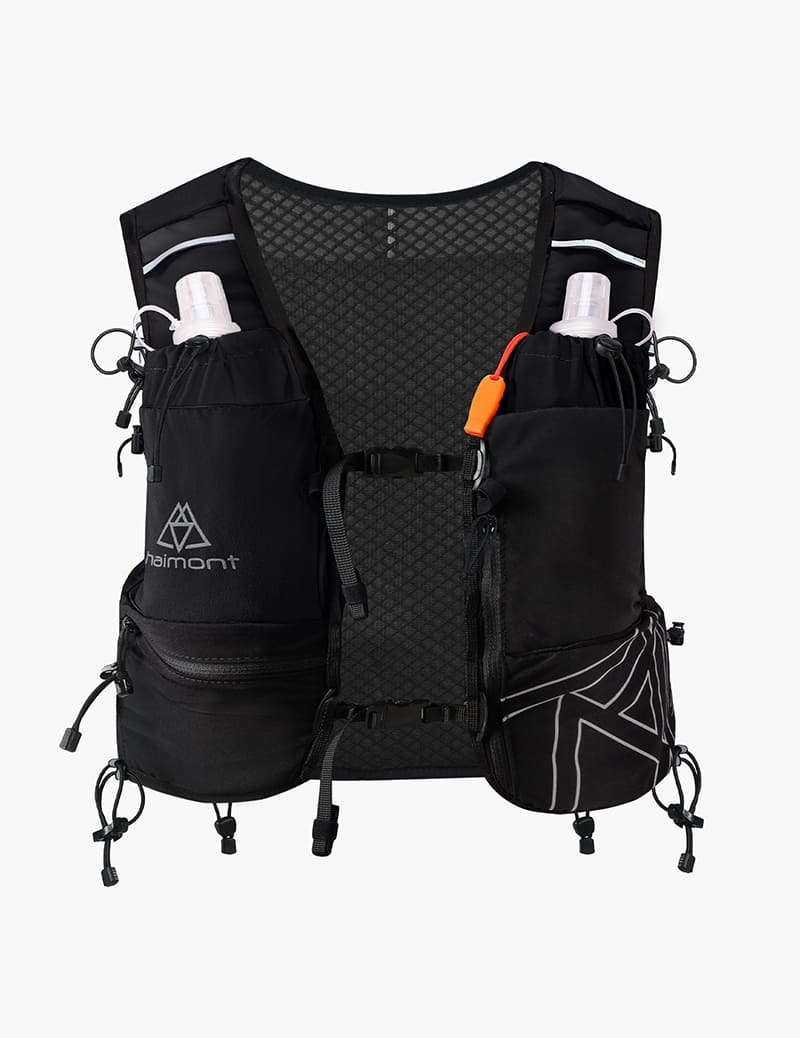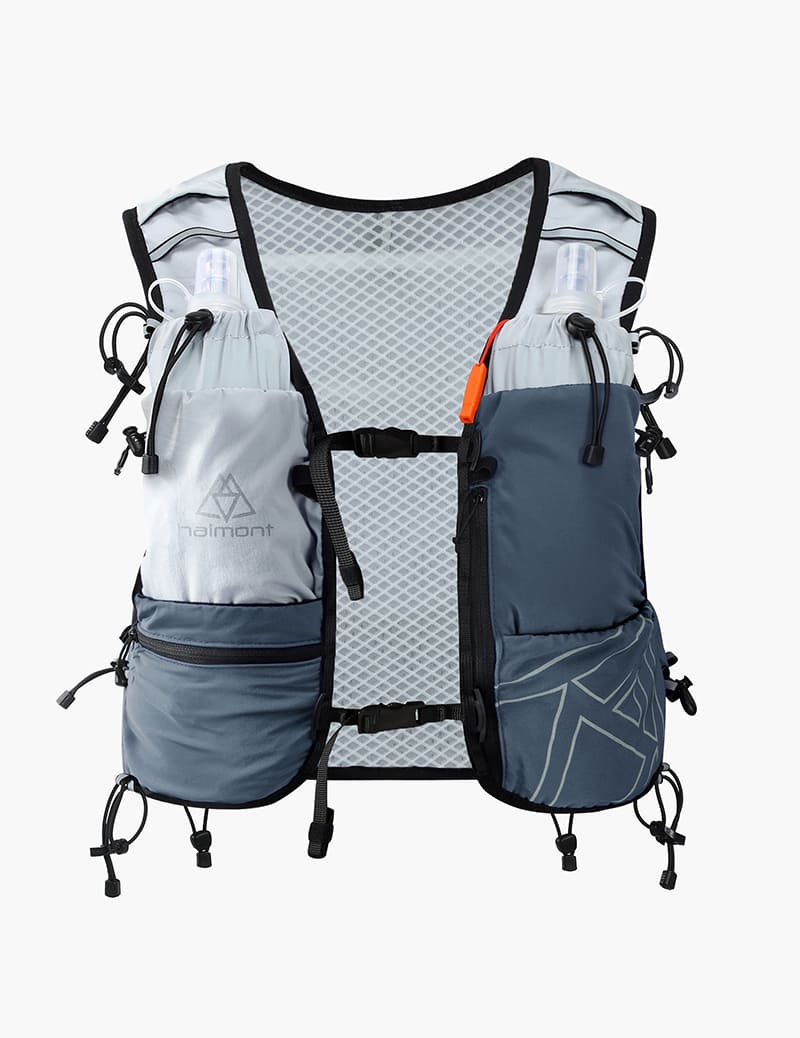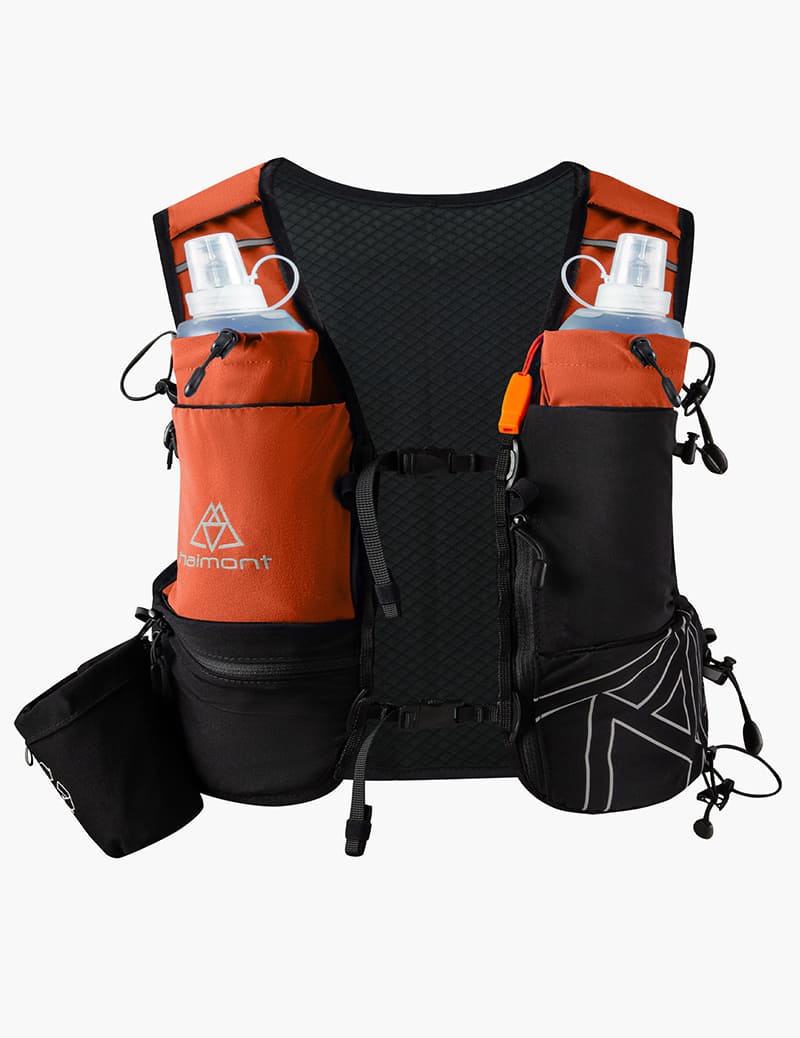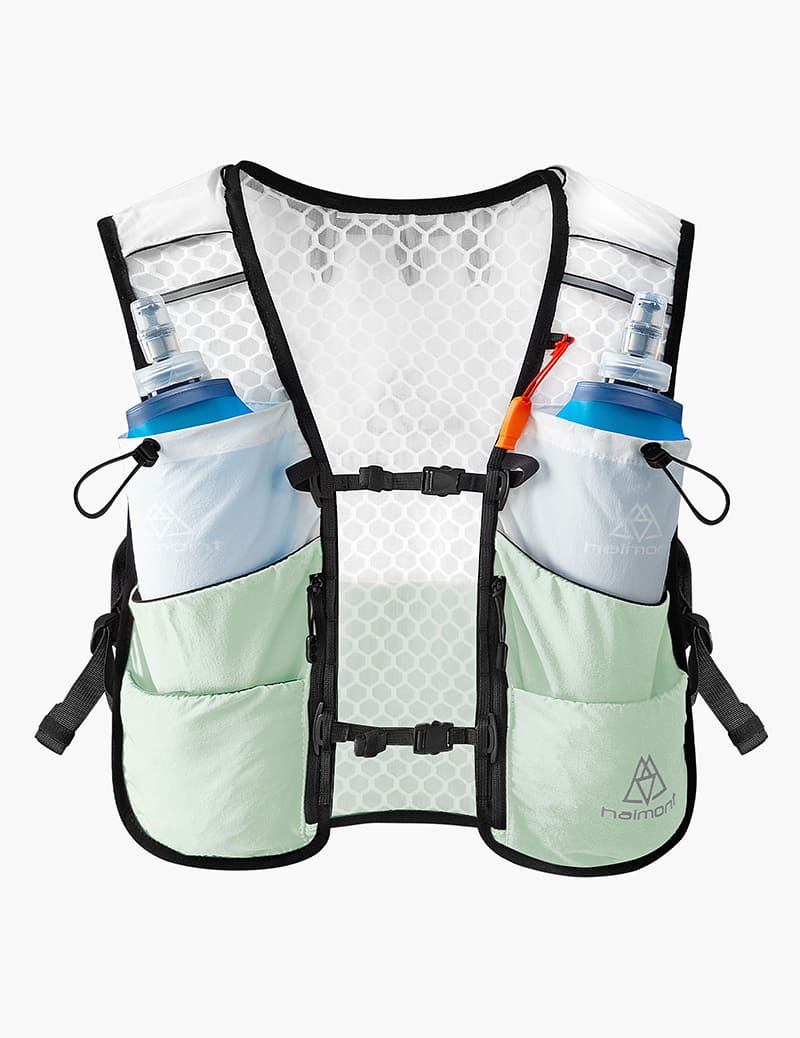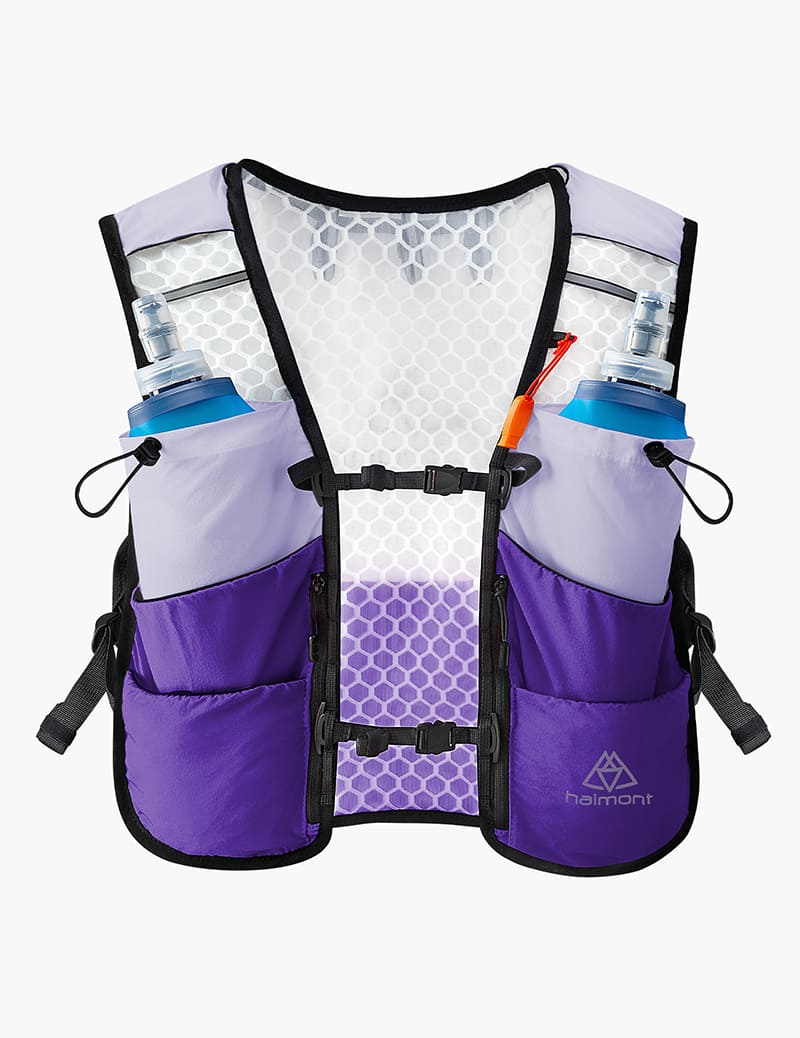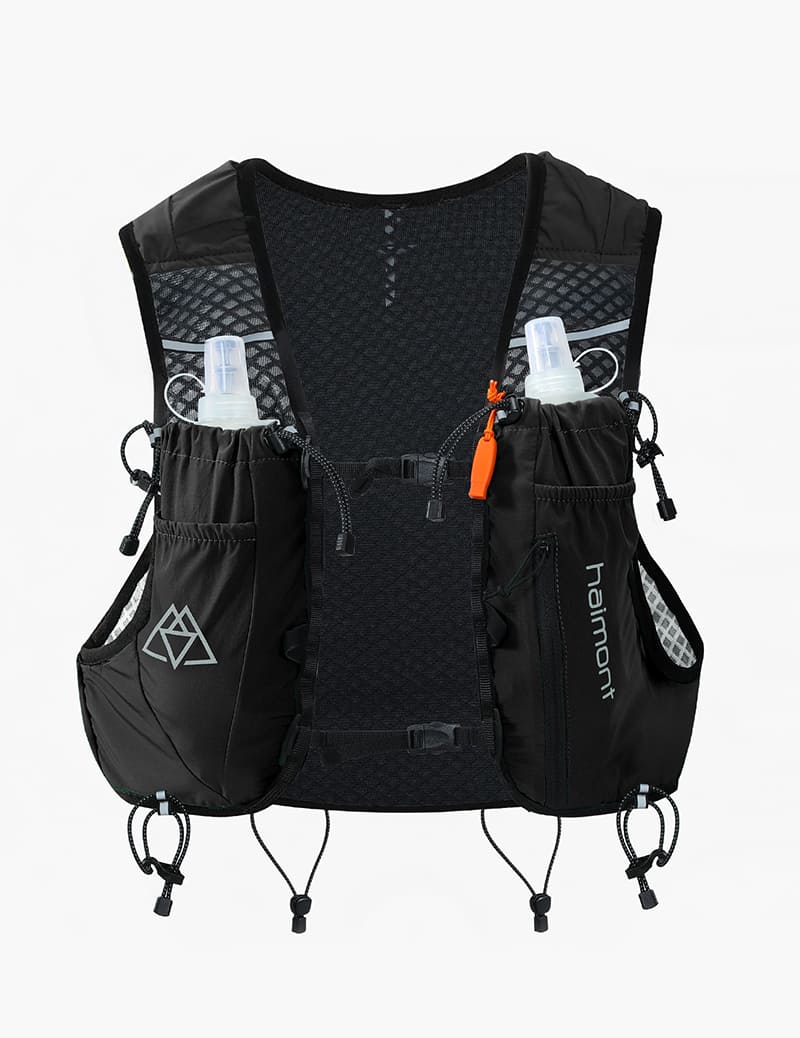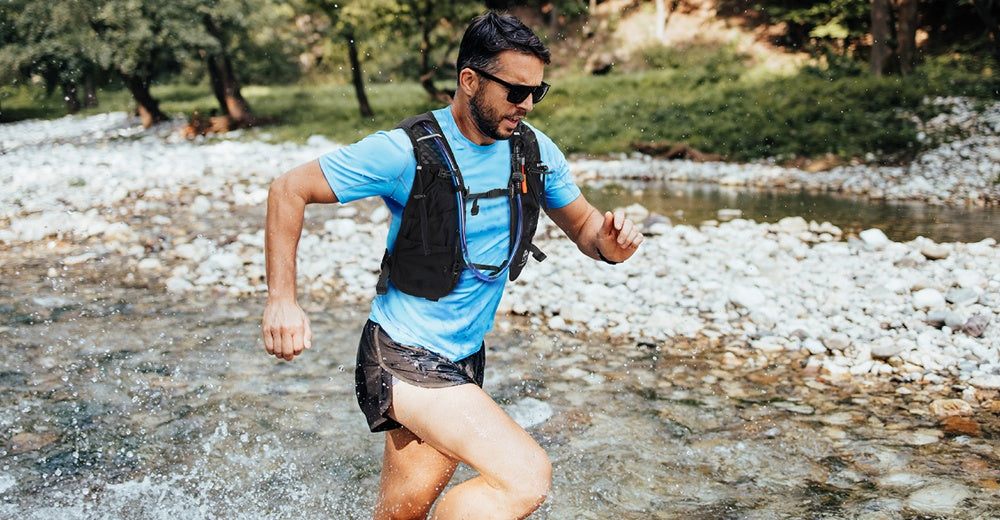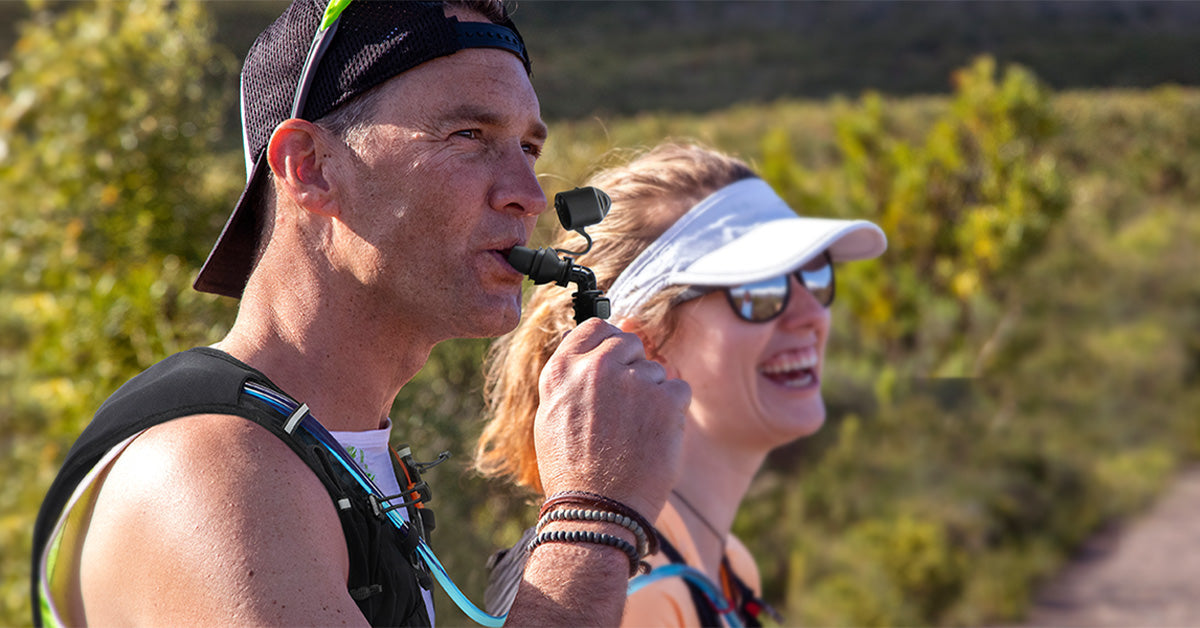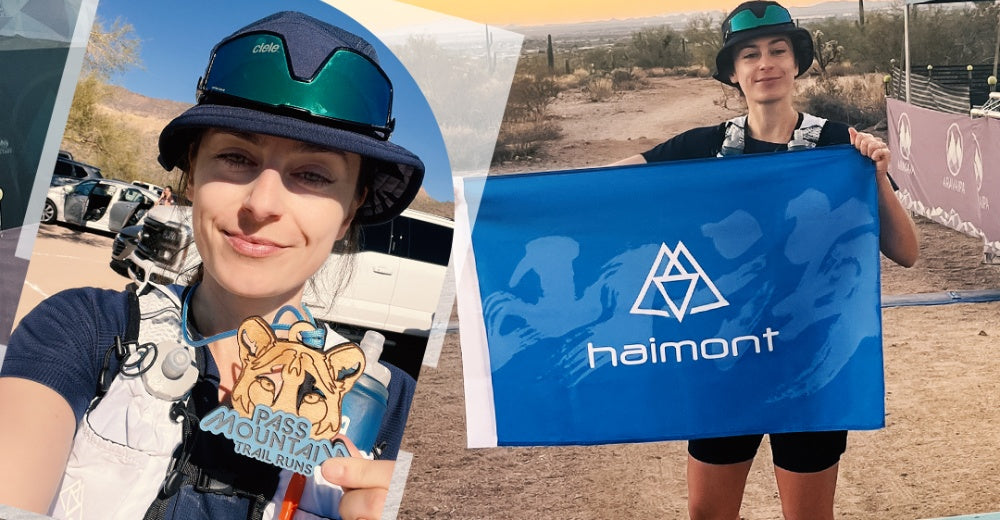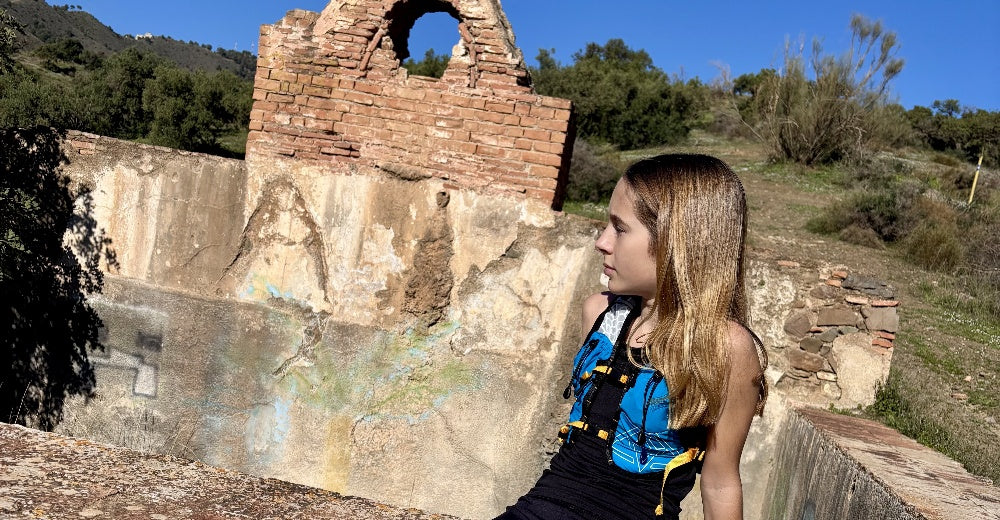Table of contents
El trail running no está destinado a ser un deporte fácil. Tienes que enfrentar un clima impredecible, caminos de montaña impredecibles y el desafío psicológico de caminar solo en una carrera larga. Entre ellos, un trail running vest adecuado puede ser más importante de lo que piensas.
No es una simple mochila para llevar cosas, sino el fulcro central de todo tu ritmo de carrera. Determina si puedes reponer suministros rápidamente, mantener la calma, mantener el centro de gravedad de tu cuerpo estable en pendientes pronunciadas, e incluso si puedes sacar rápidamente impermeables, linternas frontales o equipo de primeros auxilios en caso de clima repentino o pérdida. Muchos corredores de trail sienten que las mochilas les retrasan durante la competición. De hecho, no es que el equipo no sea lo suficientemente caro, sino que no compraron los adecuados.
Frente a una amplia gama de opciones de mochilas en el mercado, desde 2L hasta 12L, desde compartimentos para soft water bottle hasta correas para trekking pole, los novatos a menudo están confundidos, mientras que los veteranos prestan más atención a los detalles y al rendimiento real. Como una marca que se enfoca en la investigación y desarrollo de trail running equipment de montaña, Haimont sabe que un chaleco de trail running verdaderamente útil no solo debe tener una gran capacidad o una apariencia atractiva, sino que también debe ser un producto basado en las necesidades reales de los corredores y que haya sido producido a través de innumerables pruebas de campo y un pulido detallado.
Entonces, ¿qué tipo de mochila tipo chaleco es adecuada para ti? ¿A qué funciones debes prestar atención al comprar? ¿Es mejor la mochila más cara? A continuación, usemos un artículo Análisis Completo de Mochilas para Trail Running para ordenar tus ideas: antes de dirigirte a las montañas, primero elige al compañero cercano más confiable.

Selección de capacidad: no es que cuanto más grande mejor, sino que sea justo la adecuada
Al elegir una mochila tipo chaleco para trail running, la capacidad es el primer factor que debes considerar. Pero muchas personas tienden a creer erróneamente que cuanto mayor sea la capacidad, mejor, y que siempre es correcto llevar más cosas. De hecho, cuanto mayor es la capacidad, menos práctica es. El trail running enfatiza el ajuste ceñido, la reducción de peso y la eficiencia. Elegir la capacidad adecuada puede mantener tu ritmo durante todo el proceso; elegir la capacidad incorrecta hará que la mochila se mueva, que el centro de gravedad se desplace y será incómodo de llevar, lo que consumirá tu valiosa fuerza física y concentración.
La capacidad comienza con el trail running belt: el umbral práctico del trail running
Antes de comprar una mochila tipo chaleco para trail running, primero debes hacerte una pregunta más fundamental: ¿Realmente necesitas una mochila tipo chaleco?
En el sistema de equipamiento para trail running, la mochila tipo chaleco es uno de los equipos principales, pero no es la primera opción para todos los escenarios. En una época en la que la reducción de peso se ha convertido en una tendencia, muchos corredores prefieren usar una solución minimalista como un trail running belt en eventos o entrenamientos de corta distancia y bajo suministro.
Comparación de métodos comunes de transporte para trail running: desde cinturones para trail running hasta mochilas tipo chaleco para trail running
|
Rango de Capacidad |
Referencia de Distancia |
Escenarios Adecuados |
Artículos Típicos Transportados |
|
1L ~ 3L (Cinturón de Trail Running) |
5K ~ 15K |
Entrenamiento de trail urbano, carreras cortas de trail, carreras con estaciones de ayuda frecuentes |
Teléfono, llaves, geles energéticos, tabletas de electrolitos, botella blanda pequeña (250ml), protector solar, cápsulas de sal |
|
5L (Chaleco Ligero para Trail Running) |
15K ~ 25K |
Entrenamiento diario en montaña, carreras de trail de corta a media distancia, clima estable |
2 x botellas blandas de 500ml, suplementos energéticos, cortaviento, curitas, pañuelos, spray protector solar |
|
6L ~ 8L (Chaleco de Trail de Capacidad Media) |
25K ~ 50K |
Entrenamiento de montaña de día completo, carreras de ~50K, equipo obligatorio requerido |
Vejiga de hidratación o botellas blandas, geles energéticos, cápsulas de sal, chaqueta ligera para lluvia, linterna frontal, baterías de repuesto, botiquín de primeros auxilios |
|
9L ~ 12L (Chaleco de Trail de Alta Capacidad) |
Más de 50K / Carreras con equipo obligatorio |
Ultramaratones, carreras de trail de más de 100K, clima complejo, eventos de varias etapas |
Vejiga de hidratación + botellas blandas, polvo de electrolitos, capa aislante, chaqueta contra viento/lluvia, barras energéticas, GPS/botiquín de primeros auxilios, ropa de repuesto, iluminación de respaldo |
¿Cómo elegir la capacidad según los eventos o el entrenamiento?
Entrenamiento de corta distancia y trail running ligero en áreas suburbanas
Si tu distancia actual de entrenamiento o competición se concentra entre 5 km y 10 km, y las rutas son principalmente senderos de montaña, senderos de parques y senderos forestales de grava alrededor de la ciudad, entonces puede que no necesites un chaleco de trail running en absoluto. Un cinturón de trail running ajustado y estable puede satisfacer a menudo todas tus necesidades de suministros y pertenencias.
En este rango de distancia, usualmente no necesitas llevar mucha agua, y rara vez usas equipo redundante como cortavientos y linternas frontales. La ventaja del cinturón es que es extremadamente ligero y se ajusta al cuerpo, no presiona los hombros ni interfiere con la postura al correr, libera tus manos y también es conveniente para mantener el ritmo durante todo el proceso. Un cinturón bien diseñado suele tener 2~4 bolsillos elásticos con particiones, que pueden almacenar fácilmente teléfonos móviles, geles energéticos, tabletas de electrolitos, pequeñas botellas de agua blandas, protector solar y otros artículos. Algunos incluso están equipados con clips para llaves o compartimentos para auriculares, detalles prácticos.
Corredores principiantes e intermedios / carreras cortas en áreas suburbanas (5L)
Adecuado para entrenamiento de montaña de fin de semana o carreras locales en el rango de 15~25KM. En este escenario, normalmente no se necesita el sistema de reservorio de agua. Dos botellas de agua blandas en el pecho delantero + una pequeña cantidad de suministros en el bolsillo trasero son suficientes. Haimont Trail 5L se enfoca en la ligereza y el ajuste, y también considera el acceso rápido, siendo un buen compañero para corredores principiantes.
Preparación para eventos de 30KM o 50KM (6L~8L)
A medida que aumenta la distancia de la carrera y la acumulación de ascenso, los corredores necesitan llevar más geles energéticos, electrolitos, cortavientos y posibles linternas frontales. En este momento, el chaleco debe ofrecer buenas particiones, grandes bolsillos traseros y estructuras de carga estables. Haimont Trail 8L tiene un buen desempeño en eventos reales de trail running y una fuerte adaptabilidad. Es la mochila principal para la mayoría de los corredores.
Más de 100 kilómetros / travesía de varios días (9L~12L)
Cuando entras en el desafío de 100KM, UTMB y otros niveles, los organizadores a menudo requieren que lleves equipo obligatorio (como mantas térmicas, impermeables, linternas frontales, tarjetas de primeros auxilios, etc.). La capacidad insuficiente significa que podrías cambiar temporalmente la mochila antes de la carrera, lo que conlleva el riesgo de un uso desconocido. Se recomienda elegir una mochila de alta capacidad con carga estable, estructura razonable y accesorios diversos.
¿Realmente necesitas un chaleco de 12L? ——No dejes que la capacidad excesiva te lastrе
Un malentendido común es: "Me temo que no es suficiente, así que siempre es correcto comprar uno más grande."
Pero correr por senderos no es montañismo. Cada gramo de peso innecesario duplicará tu consumo de energía en pendientes pronunciadas y sprints. Un chaleco más grande tiene un cuerpo más grande, y aunque no esté lleno, es fácil tener los siguientes problemas:
- Centro de gravedad inestable, postura de carrera hundida
- Movimiento de la mochila, afectando el ritmo
- Fricción del exceso de tela, causando abrasiones
- Aumento de peso, causando sudoración severa en la espalda y fatiga temprana
El enfoque correcto es: invertir el equipo necesario según la intensidad del evento o entrenamiento, y luego elegir la capacidad adecuada. Evita la experiencia redundante de paquete grande con pocas cosas, y no dejes que la ansiedad por el equipo sea tu excusa para no correr rápido.
Ajuste y comodidad: ¿Saltará o rozará?
La capacidad suficiente es importante, pero lo que realmente determina si un chaleco para trail running vale la pena para usar todo el día es el ajuste y la comodidad. Correr es una acción repetitiva de alta frecuencia y larga duración. Cualquier holgura, movimiento o fricción puede convertirse en un colapso después de 30 kilómetros.
Un excelente chaleco para trail running debe ajustarse a ti como una segunda piel, firme y casi imperceptible.
¿Por qué es tan importante el ajuste?
El ajuste afecta no solo la comodidad, sino que también determina directamente si puedes mantener tu ritmo y eficiencia mientras corres. Los problemas comunes causados por un ajuste insuficiente del chaleco incluyen:
|
Problema de ajuste deficiente |
Manifestación específica |
Impacto |
|
Rebote |
La mochila rebota hacia arriba y hacia abajo durante descensos o sprints |
Interrumpe el ritmo, causa fatiga, puede provocar rozaduras en las correas de los hombros |
|
Desplazamiento |
Desequilibrio o distribución desigual del peso cuando está completamente cargado |
Desalineación de la postura corporal, fatiga compensatoria en los músculos de la espalda y la cintura |
|
Rozaduras |
Materiales rígidos o costuras ásperas. |
Causa abrasiones en el pecho, clavícula o axilas, especialmente cuando se suda mucho. |

¿Cómo juzgar si el diseño de ajuste de un chaleco es excelente?
Sistema de ajuste multipunto: se adapta a diferentes formas corporales y estados de peso.
Los chalecos excelentes para trail running deben tener diseño de doble hebilla en el pecho superior e inferior, y algunos también están equipados con cordones de ajuste en la cintura lateral y correas elásticas para asegurar un ajuste ceñido al cuerpo al usar diferentes prendas o cargar distintos objetos.
- Cinturón de ajuste frontal en el pecho: dos juegos, superior e inferior, para evitar saltos arriba y abajo.
- Cinturón elástico lateral en la cintura: se ajusta a ambos lados de las costillas, sin afectar la respiración.
- Estructura de marco trasero de alta elasticidad: no dificulta el movimiento libre al mover los brazos durante la carrera.
Confección tridimensional: considera el ajuste dinámico bajo la postura de carrera.
Correr no es estar estático, especialmente en trail running, la postura de carrera suele ir acompañada de inclinación hacia adelante, subida, bajada rápida y otros movimientos. Un buen chaleco debe poder adaptarse a estos cambios dinámicos, ajustarse al cuerpo pero sin opresión, estar cerca de la espalda pero sin restringir la respiración.
- La estructura general del chaleco debe tener una ligera curva para ajustarse a la curva de la espalda.
- El hombro delantero debe cortarse con holgura para evitar rozaduras en las axilas al mover los brazos.
- La base de la mochila no debe comprimir la columna lumbar, de lo contrario habrá una sensación de opresión prolongada.
Consejo práctico: Intenta saltar unas cuantas veces mientras lo usas, simula movimientos de subida y bajada, y confirma si la mochila se mueve o tira.
Selección de tejido: Suave y transpirable, el sudor no es un problema
No importa cuán científica sea la estructura, si el material no es adecuado, no será seguro usarlo todo el día.
- Malla de alta elasticidad: Puede estirarse naturalmente con los movimientos del cuerpo para reducir las marcas.
- Capa absorbente de humedad de secado rápido: Reduce la acumulación de sudor y evita la fricción húmeda.
- Tratamiento de sobrehilado en el borde: Previene abrasiones en la clavícula y el pecho.
El tejido exterior de la serie Haimont trail está tratado con un recubrimiento repelente al agua, que puede manejar eficazmente los problemas de filtración de humedad causados por lluvia ligera, sudor y contacto frecuente con manos mojadas.
Las corredoras deben prestar más atención: el ajuste no es solo cuestión de talla, sino también de estructura
Muchas marcas de trail running usan mochilas de corte universal, ignorando las diferencias estructurales de las mujeres en ancho de hombros, forma del pecho y longitud de la espalda, lo que provoca los siguientes problemas cuando las mujeres las usan:
- Las correas de los hombros son demasiado anchas, resbalan o rozan contra la clavícula.
- El bolsillo del pecho está mal posicionado, causando presión o incomodidad al usarlo.
- La espalda no está ajustada, causando que el depósito de agua & se balancee.
Haimont está a punto de lanzar una serie exclusiva para mujeres, optimizada completamente en cuanto a la curva de las correas de los hombros, reserva en el pecho y altura del sistema de transporte para asegurar que no sea una versión más pequeña del modelo para hombres, sino que esté verdaderamente diseñada para mujeres.
¿Depósito de agua o botellas blandas? Tus hábitos de hidratación lo determinan todo
En el trail running, la hidratación oportuna y conveniente es clave para mantener el rendimiento y la seguridad. ¿Pero cómo llevar agua? ¿Usar una botella blanda en el pecho o un depósito de agua en la espalda? Las dos soluciones parecen ser solo diferentes formas de transportar agua, pero en realidad afectan la frecuencia de ingesta, el ritmo de carrera e incluso la estrategia de competición. Solo entendiendo sus ventajas, desventajas y escenarios aplicables se puede lograr realmente tener agua en la mano, sin confusión en la mente.
Comparación de dos métodos principales de hidratación
|
Método de hidratación |
Ubicación |
Capacidad típica |
Ventajas |
Desventajas |
|
Botella blanda |
Bolsillos frontales en el pecho del chaleco |
250–500ml cada uno, usualmente se llevan en pares |
Acceso fácil, conveniente para el control de porciones, rápido de rellenar |
Capacidad limitada, requiere uso de las manos |
|
Bladder |
Compartimento principal en la parte trasera del chaleco |
1.5L–2L |
Gran capacidad, hidratación manos libres, suministro de agua estable |
Difícil de limpiar, difícil de medir el agua restante, no es rápido de cambiar |
La diferencia clave es: ¿Estás dispuesto a detenerte y tomar una botella de agua blanda, o quieres seguir absorbiendo agua?
¿Cuál es más adecuado para ti? Basado en tus hábitos, el evento y tu método de correr.
Elige una botella de agua blanda si:
- Te gusta beber agua a sorbos en cualquier momento y controlar la cantidad de agua que bebes.
- Hay múltiples puntos de suministro para la competencia/entrenamiento, por lo que no necesitas llevar mucha agua.
- Te gusta controlar el peso y no quieres llevar una bolsa grande o usar una manguera de agua.
La mochila chaleco de la serie Haimont Trail está equipada con un bolsillo de botella de agua de alta elasticidad en los lados izquierdo y derecho del pecho frontal, que puede fijar firmemente la botella de agua blanda, y no es necesario quitarse la mochila chaleco para tomarla, solo tómala con la mano → bebe agua → vuelve a ponerla, y es estable y no se mueve durante todo el proceso.
Elige un depósito de agua si:
- La distancia de la carrera es larga (más de 50K), o la fuente de agua está lejos.
- No quieres tomar la botella de agua con frecuencia y prefieres beber agua a través de una pajilla mientras corres.
- Usas bastones de trekking o equipo de mano, y no es conveniente liberar las manos para tomar la botella de agua.
Cada serie de Haimont Trail está equipada con un compartimento principal para depósito de agua + diseño de salida para tubo de agua, que puede soportar depósitos de agua de 1.5~2L de capacidad, y está equipada con puntos de fijación para el tubo de agua para evitar que el tubo se mueva e interfiera con la postura al correr.
La combinación de sistema dual es más adecuada para largas distancias o clima variable
Muchos corredores avanzados de 50K~100K elegirán una estrategia de hidratación de coexistencia doble:
|
Método de hidratación |
Depósito de hidratación |
Botellas blandas frontales para el pecho |
|
Uso principal |
Usado como hidratación base para mantener un ritmo de hidratación constante |
Usado para acceso rápido, típicamente llenado con bebidas electrolíticas o fluidos energéticos |
|
Colocación |
Colocado en la espalda, difícil de reemplazar durante la carrera |
Fácilmente accesible en el pecho, conveniente para intercambios rápidos o mezclar nutrición |
Además de reponer agua, no ignores estos detalles del sistema de bebida:
¿La mochila tiene una salida reservada para el depósito de agua?
Las mochilas Haimont tienen todas salidas reservadas para el depósito de agua y están equipadas con clips para fijar la tubería de agua y evitar que esta se mueva y afecte el movimiento.
¿La botella blanda tiene diseño elástico y antideslizante?
Nuestra botella blanda tiene malla elástica antideslizante + cinturón de cierre en la base, que puede fijarse firmemente incluso si el nivel del líquido en la botella blanda baja, sin saltar ni deslizarse.
¿Se puede ajustar la capacidad de forma flexible?
La botella blanda puede seleccionarse entre modelos de 250ml~500ml según los requisitos de la ruta del día, y se recomienda que el depósito de agua elija un estilo con escalas para un llenado preciso antes de la carrera.
Comodidad de limpieza:
La botella blanda es fácil de limpiar y se seca rápido, adecuada para entrenamiento diario; se recomienda que el depósito de agua esté equipado con un kit de limpieza especial y se maneje a tiempo después de la carrera para evitar el moho.
Estructura de almacenamiento: ¿Puedes conseguir lo que necesitas, lo que llevas?
Un excelente chaleco para trail running no es solo cuánto puede contener, sino que esté cargado científicamente y sea fácil de obtener. Correr en montaña no es como correr en la carretera en la ciudad. No puedes predecir si habrá tormenta, sol abrasador, barro o rocas, y no puedes resolver el problema esperando a detenerte y mirar despacio. Cuanto más complejo sea el terreno y más larga la carrera, más necesitas obtener lo que necesitas de inmediato.
Y la realización de todo esto depende de si la estructura de almacenamiento es razonable.
Detalles del área de almacenamiento: Cada bolsillo tiene un sentido de misión
Las siguientes son áreas comunes de almacenamiento y usos recomendados de los chalecos para trail running para ayudarte a encontrarlos con los ojos cerrados mientras corres:
|
Área |
Uso recomendado |
Enfoque del diseño |
Aspectos destacados del diseño Haimont |
|
Bolsillos frontales para frascos (x2) |
Transporte de frascos blandos |
Malla elástica para evitar rebotes, parte inferior ajustada para evitar deslizamientos |
Ajuste ergonómico para postura estable al correr; soporta frascos blandos de 250–500ml |
|
Bolsillos frontales elásticos (2–4) |
Tabletas de sal, geles energéticos, bálsamo labial, electrolitos |
Apertura amplia para fácil acceso; ajuste ceñido para evitar sacudidas o rozaduras |
Forro interior añadido para reducir la absorción de sudor y la irritación de la piel |
|
Bolsillo de seguridad frontal con cremallera |
Teléfono, identificación, dinero de emergencia |
Materiales impermeables o resistentes al sudor; diseño antirrobo ceñido al cuerpo |
Colocación discreta, cremallera suave, fácil operación con una mano |
|
Bolsillos laterales en la cintura / Bolsillos tipo ala |
Combustible alto en calorías (barras, nueces), protector solar |
Aberturas ligeramente anguladas, ajuste ceñido para evitar que los objetos se caigan |
Borde elástico para una recuperación suave y fácil reinserción sin que se deslice |
|
Compartimento principal trasero |
Bolsa de hidratación, ropa de repuesto (chaqueta cortaviento/impermeable), botiquín |
Objetos más pesados cerca de la espalda; mantiene el ajuste mochila-cuerpo |
Estructura compartimentada con almacenamiento principal alto para alivio de presión y comodidad en la espalda |
|
Compartimento secundario trasero / Bolsillo superior |
Linterna frontal, baterías, pañuelos, mapa, reserva de energía |
Acceso rápido sin quitar la mochila |
Diseño de acceso con un solo giro y una mano; ideal para ascensos o reabastecimiento durante la carrera |
|
Sujeción para bastones de trekking |
Bastones de trekking plegables |
Fácil de sujetar/quitar; no interfiere con el movimiento de los brazos |
Bucle Z para bastones en la parte trasera y lateral inferior con correas de estabilización laterales |

¿Por qué hurgar en la mochila es un tabú en el trail running?
En las carreras de trail running, especialmente las de más de 50K, uno de los errores fatales comunes es: detenerse a hurgar en la mochila para encontrar algo.
Esto no solo hace perder tiempo, sino que también:
- Interrumpe el ritmo y dificulta restaurar rápidamente la frecuencia cardíaca.
- Ser adelantado por el oponente, frustración psicológica.
- Cuanto más rebuscas, más desordenado se vuelve, y los objetos se pierden o dañan fácilmente.
- La exposición al viento frío o al sol abrasador aumenta el riesgo.
El objetivo de la estructura de almacenamiento científica es: ya sea tomar pastillas de sal, ponerse cortavientos o reponer geles energéticos, debe completarse de forma continua sin interrumpir el ritmo.
Concepto de diseño de almacenamiento Haimont: planificar chalecos como planificar cocinas
En el diseño de las mochilas de trail running de la serie Haimont Trail, adoptamos el principio de almacenamiento de alta frecuencia adelante, baja frecuencia atrás, y prestamos atención a los siguientes detalles clave:
- Diseño del bolsillo frontal ligeramente inclinado: ya sea para sacar o guardar, sigue el flujo.
- Compartimento principal de múltiples capas: la bolsa principal es para objetos grandes, y la secundaria para objetos pequeños, sin confusión.
- Compartimento de emergencia independiente: sácalo en el momento crítico, sin necesidad de buscarlo por mucho tiempo.
- Capa elástica comprimida: evita que la espalda se abulte y afecte la postura al correr.
- Punto rápido para colgar bastones de trekking: se puede colgar con una mano, adecuado para bastones Z y bastones trípticos.
Poder ajustarse no significa que sea lo suficientemente bueno, poder sacarlo es la verdadera habilidad.
El trail running no es un viaje de equipaje, sino un desafío dinámico rítmico de alta intensidad. Una estructura de almacenamiento razonable puede ayudarte a ahorrar tiempo, reducir movimientos, mantener el ritmo e incluso ganarte esos críticos 30 segundos en condiciones extremas.
El chaleco de trail running Haimont utiliza una lógica de zonificación profesional y el pensamiento de los corredores para crear una experiencia de equipo fácil de tomar y sin desorden durante toda la carrera. Realmente logra: cuando lo necesitas, nunca te hace esperar ni un segundo más.
Las funciones ocultas en los chalecos de trail running: ¿las has notado?
Al elegir un chaleco de trail running, la mayoría de los corredores se enfocan en si tiene suficiente capacidad, cuántos bolsillos tiene y si se ajusta al cuerpo. Pero lo que realmente te permite completar la carrera de forma estable cuando el viento y la lluvia cambian repentinamente, la energía se agota y cae la noche, suelen ser algunos detalles pequeños subestimados: estas funciones ocultas aparentemente insignificantes son la línea divisoria entre profesionales y principiantes.
Puntos de colgado para equipo de emergencia: pequeños lazos colgantes, grandes funciones
Cuando muchos corredores de trail usan por primera vez chalecos de trail running, notarán algunos pequeños lazos colgantes en la mochila que al principio no saben para qué sirven. Estos pequeños diseños están realmente reservados para situaciones extremas:
- Puede colgar silbatos, tarjetas de emergencia, placas con números de identificación.
- Puede arreglar temporalmente llaves, luces pequeñas y cajas de auriculares.
- Cuando estés en apuros en las montañas, puedes colgar luces reflectantes o localizadores de rescate en lo alto de tu espalda para aumentar la visibilidad en búsqueda y rescate.
La capacidad de gestión térmica de las telas: no solo transpirable
Muchas mochilas están marcadas con malla transpirable, pero en clima caluroso y húmedo, sol de altura o bajas temperaturas después de la lluvia, descubrirás que los materiales verdaderamente profesionales necesitan regular la temperatura y no solo evitar la sensación de sofoco al usarlos.
- Haimont usa material transpirable elástico en cuatro direcciones en la espalda, equipado con una estructura de ventilación microporosa, que puede mantener la superficie de la piel relativamente seca entre el sudor en subida y el frío del viento en bajada, reduciendo la estimulación por frío después de sudar.
- Las correas de los hombros y del pecho usan una capa interna suave y amigable con la piel para evitar la sensación granulada de sal-álcali después de que el sudor se seca, reduciendo el riesgo de quemaduras por fricción
Recordatorio especial: Fuera de carretera por la noche o en ambientes de gran altitud, las espaldas húmedas y frías son muy propensas a causar calambres o hipotermia. Elegir el chaleco adecuado para la gestión térmica es más efectivo que usar una prenda extra.
Sistema reflectante: Puede que nunca lo uses, pero usarlo una vez puede salvar tu vida
El trail running de larga distancia a menudo se extiende hasta la noche, e incluso el entrenamiento diurno puede oscurecerse debido a cambios repentinos del clima o al entorno del bosque montañoso. En este momento, el diseño reflectante puede mejorar significativamente tu visibilidad en senderos forestales, crestas, niebla o caminos nocturnos:
- La serie Haimont Trail tiene tiras reflectantes en el pecho frontal, hombros traseros y alas laterales del chaleco, que pueden ser identificadas rápidamente incluso si solo están iluminadas por luz débil (como luces de coche, faros).
- Algunas versiones soportan la conexión con el punto de colgado de la luz LED trasera, haciendo que correr de noche sea más seguro.
Silbato de emergencia: ¿Realmente sabes dónde está?
Casi todos los eventos regulares de trail running requieren llevar un silbato de emergencia en el equipo obligatorio, pero muchas personas olvidan que existe, o incluso no pueden encontrarlo cuando lo necesitan.
- La mochila de la serie Haimont Trail integra el silbato y la hebilla del pecho en un solo diseño, lo que no solo reduce el riesgo de pérdida, sino que también permite un acceso rápido mientras corres.
- El silbato está hecho de material compuesto ABS de alta frecuencia, que sigue siendo penetrante en viento y lluvia y no fallará debido al sudor o caídas.
Consejo: Antes de cada salida, asegúrate de conocer la ubicación del silbato. Es mejor practicar la acción de sacarlo una vez mientras corres.
Punto rápido para colgar los trekking poles: Puedes cambiar el equipo sin detenerte
Al subir pendientes técnicas o descensos largos, trekking poles son una ayuda importante para muchos corredores de trail. Sin embargo, el acceso frecuente o almacenamiento de los trekking poles interferirá con el ritmo e incluso aumentará el riesgo de caídas.
La mochila de trail Haimont está equipada con un punto de colgado rápido en forma de X en la espalda y una ranura horizontal en el dobladillo, para que puedas recoger o tomar el bastón rápidamente con una mano mientras corres
Después de fijar el bastón, no se balanceará de lado a lado, no pateará tus piernas ni presionará tu espalda
Estructura inteligente anti-balanceo: Solo porque no lo sientas no significa que no esté funcionando
El chaleco no se balancea cuando corres, en realidad depende del trabajo realizado por el diseñador detrás de él:
- La partición interna de la mochila adopta una estructura centralizada en forma de V para el centro de gravedad, el compartimento principal está en la parte superior y los objetos pesados no se hunden.
- Todas las bandas elásticas y cordones han sido ajustados repetidamente para asegurar que puedan mantener el ajuste incluso si la carga cambia.
- Cordón de compresión multipunto + sistema de ajuste lateral en la cintura para evitar que la mochila se caiga debido al desgaste físico en largas distancias.
La función oculta es lo que crees que no es importante, pero realmente determina si puedes persistir en el momento extremo.
El verdadero valor profesional de un chaleco de trail running no es que siempre uses todas sus funciones, sino si puede mantenerse firme y protegerte en el segundo crítico cuando la situación estalla, el ritmo se interrumpe, llega la noche y la fuerza física se agota.
En el mundo del trail running, el equipo nunca es tan simple como llevar más, sino que se trata del ritmo de cada paso, la suavidad de cada respiración y si puedes regresar seguro de un desafío en la montaña. Elegir un chaleco de trail running que realmente te convenga es una respuesta precisa a tu condición física, hábitos y objetivos. La capacidad debe ser la justa, el ajuste debe ser estable, la fuente de agua debe estar fácilmente disponible y el almacenamiento debe ser claro de un vistazo. Esas funciones ocultas pasadas por alto a menudo brindan un apoyo real cuando estás más cansado y vulnerable.
En Haimont, siempre insistimos: cada chaleco está diseñado para corredores y para las montañas. Sin diseños redundantes y llamativos, sin abandonar detalles clave de seguridad. Porque creemos que el significado del equipo no es presumir, sino acompañarte a completar el viaje más real desde la línea de salida hasta la meta cada vez.
Antes del próximo viaje de trail, no olvides reexaminar tu chaleco, puede ser tu compañero más silencioso pero más importante. Y si aún estás buscando el primer chaleco de trail running que realmente te quede, bienvenido a conocer Haimont, estamos listos para tu próxima aventura en la montaña.


